|
|

LED Thoughts
by Gary
Blankenship
Around 1979-80, I got
a 10-watt solar panel for a 24-foot sailboat (a sloop rig held
up by a maintenance-intensive matrix of fiberglass-covered wet
rot). Ever since, the idea of energy independence, not only
afloat but on land, has provided many hours of pleasant contemplation.
The evolution of LED lights
has aided in those agreeable thoughts. In a way they parallel
the development of solar cells. At first expensive and modest
in ability, the quality is improving as the price comes down
(the last 10-watt solar panel I bought cost, in real dollars,
about one fifth to one sixth of that initial panel and small,
handheld LED flashlights cost only a fraction of what they did
a couple years ago).
Most people by now probably
know the advantages of LEDs — low power consumption, little
heat output compared to incandescent bulbs, and incredibly long
bulb life. They will also continue to put out reduced but useable
light with a nearly dead battery that will not light an incandescent
bulb. According to Alpenglow, makers of high quality flourescent
cabin lights, LEDs still are not quite as efficient as flourescent
for large cabin lights, but they are using red LEDs for night
light options on their lamps.
Practical Sailor in its
recent review of cabin lights, noted that great strides are
being made in LED lights almost monthly. (I admit to getting
some sticker shock at the price of the LED lights evaluated;
they ranged from about $72 to almost $200. The magazine rated
the Alpenglow light set on high as “bright” and
drawing .54 amps; the brightest LED fixture was rated at “medium”
and drew .25 amps.) What surprised me was discovering when bopping
around the Internet is that LED lights are now available in
a wide variety of 12-volt applications, including in bulbs that
fit commonly available 12-volt marine lighting fixtures. I was
able to add six LED fixtures around our 30-foot boat, in addition
to the three older type LEDs already installed. The total cost
for the upgrade was around the $72 that Practical Sailor had
for its cheapest LED light, but I’m sure their lights
have more style . . . .
Before the details, some
caveats. LED lights are frequently promoted as “super
bright” or some similar verbiage. Let’s be honest.
Although things are changing the only thing super bright about
a super bright LED bulb is its name. A single bulb isn’t
going to put out that much light. Put enough of them together,
however, and you can get a useable light. Secondly, LEDs are
directional in that each one puts out light in a fairly narrow
cone. Not bad if you need a directional light (and most cabin
lights seem to get mounted on bulkheads or ceilings), but if
you want one that illuminates a circle, you have to find a bulb
with LEDs mounted all around.
An interesting side effect
is you don’t get blinded by an LED light unless you look
directly at it (in fact it can be painful if you’re up
close, and dangerous if it’s a UV light because you won’t
feel pain from rays that can damage your eyes. Don’t mount
UV LEDs on your boat. . . .). If you can mount LEDs in recessed
or out of the way areas, you’re less likely to be “dazzled”
at night than with an incandescent. Also, LEDs come in almost
any color but the white ones actually put out a bluish-white
light. Some people might find that a bit harsh; I prefer it
to the “warm” incandescents. Finally, some LEDs
are brighter than others. If you’re buying bulbs or lights,
try to get both brightness figures (usually expressed in MCDs
for millacandelas) and power consumption (usually expressed
in milliamps).
The first LED lights added
to my boat came from a South Florida supplier from whom I had
purchased that last 10-watt solar panel three or four years
ago. The company sent me a catalog with the solar cells, which
included these three-LED modules. They were advertised as waterproof
and came complete with switch and an articulated neck that allowed
the lights to swivel. I bought three at $31 each and mounted
them in the boat, intending them as reading lights. One swivels
between the chart table and a single berth, and another between
the galley and the second berth. The third is in the forward
cabin/storage area. As reading lights, they work well for the
berths. As area lights, they are inadequate. You can see in
the cabin with them on, but the best word for the ambient level
is gloomy. The one light is too directional to light up the
whole chart table. In addition, the articulating necks have
broken on two of the lights; those lights droop like . . . well,
make up your own image.
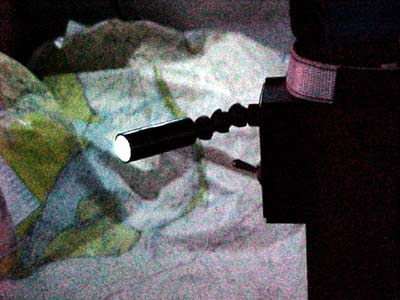
With three LEDs each, these were the first LED fixtures installed
on the boat. Good for reading, but not area lighting. In the
background is the chart table.
I’ve forgotten the
exact power consumption of these lights, but its something on
the order of an amp hour per day — for all three combined.
In other words, with only the 10-watt solar panel, even if all
three lights were left on, the battery won’t run down,
barring a couple months of heavy clouds. Pretty neat for reading
lights.
Until I started browsing
on the web, the only other LEDs I saw designed for marine use
were generally designated as “courtesy” lights and
have three LEDs. They are not focused like my reading lights,
which meant they are generally too dim to read or see much by.
The price also seemed high for a fairly dim light — $25
to $30.
But the Web revealed LEDs
intended for truck and automotive use. Several companies are
making red and amber LEDs designed to be side and marker lights
for trailers and the like, and at least the red ones would seem
to be effective as night lights. They also were waterproof.
Further research showed there are now a wide variety of bulbs
on the market to fit a variety of fixtures, from regular flashlight
variety to 12-volt fixtures and even 110-volt regular light
sockets. Some LED bulbs also come in their own housings, ready
to mount and use.
I dealt with an Arizona
company, found at www.superlumination.com.
For interior lighting, several of their 39 mm long “festoon”
bulbs — the tubular type bulbs frequently found in automobile
interior dome lights — were ordered, both white for regular
use and red for night lights. They have nine LEDs each, aligned
in two rows and lighting a decently wide arc. Also obtained
were two small dome lights, 1 3/4-inch in diameter, with eight
LEDs and a plastic cover designed to disperse the light over
a wider angle. These lights are advertised as waterproof and
even capable of being mounted underwater.
 The nine-LED festoon lights used in the
Seafit and auto interior light fixtures. There are 39 mm long;
three other sizes are also available, as are three-LED versions.
Photo courtesy of Superlumination.
The nine-LED festoon lights used in the
Seafit and auto interior light fixtures. There are 39 mm long;
three other sizes are also available, as are three-LED versions.
Photo courtesy of Superlumination.
The domelights are rated
at 60,000 MCDs and consume 60 milliamps — or about 16
hours to use one amp hour. My impression is the festoon bulbs
are quite a bit brighter, more than would be explained by one
extra LED, and that’s backed by the technical data. They
put out 75,000 MCDs but only use 50 milliamps, or 20 hours to
consume an amp hour. They’re also more directional.
 The eight-LED dome light. Two, with switches,
were installed. They have sticky backs for mounting, but contact
cement was also used. Less than two inches in diameter. Photo
courtesy of Superlumination. A three-LED version is also available
as are a variety of colors.
The eight-LED dome light. Two, with switches,
were installed. They have sticky backs for mounting, but contact
cement was also used. Less than two inches in diameter. Photo
courtesy of Superlumination. A three-LED version is also available
as are a variety of colors.
To mount the festoons,
I got a Seafit economy dome light from Boat/U.S., normally $10
but discounted to $5 because of a small crack in the white plastic
cover. It has a three-way switch and takes two white lights
for normal work and one red light for night vision. At an auto
parts store, I picked up some auxiliary interior lights with
clear covers that hold the same size bulb and include a built-in
switch. The price was less that $3 each. (Okay, so they may
not hold up great in a marine environment, but this is for a
test.) The dome LEDs need switches, which came from Radio Shack.
Both the bulbs and dome lights were $6.99 each, not including
a modest shipping charge.
How did it work out? Well
first, compared to the incandescent festoon lights that came
standard in the various fixtures, the nine-LED festoons were
not quite as bright. I don’t have metering equipment to
measure, but I’d guess the LEDs are about 50 to 75 percent
as bright. The LED illumination, though, is noticeably more
even. There’s no rating on the incandescent bulbs that
came with the fixtures, but they look about the same as the
10-watt bulbs in my running lights. If that’s the case,
each bulb would draw a bit less than an amp.
The festoons at 50 milliamps, would run for 20 hours on one
amp hour, or about the same energy to run a regular bulb for
one hour. Quite a savings in power. In fact, if all the LEDs
are tuned on at once, including the reading lights, the total
consumption is less than half an amp.
The Seafit light was mounted
over the full-size chart table, about 30 inches above the surface.
Since the LEDs produce an even light, I took the cover off.
The results are great. With the two white lights on, it’s
easy to read the chart or do any navigation-related activity
on the table. Even with the single red light, it’s possible
to make out most of the information on a chart and to see what’s
needed on the table.
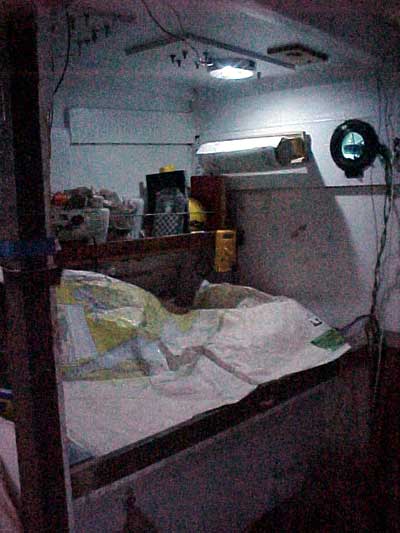
The Seafit economy dome light with two of the nine-LED festoons
does a great job of lighting the chart table and navigation
area. It also has one red light for night vision.
The auto interior lights
were mounted one each about three feet over the head of each
berth. They’re bright enough to read by, but I think I’d
get eye strain after a while. The older, three-LED spotlights
will work fine for that. More importantly, the new lights provide
enough light to move easily around the main cabin without the
half blind feeling. The gloom is gone. It ain’t super
bright, but it’s more than adequate. I’m going to
add a third one of these in the main cabin with a red light
for night use.
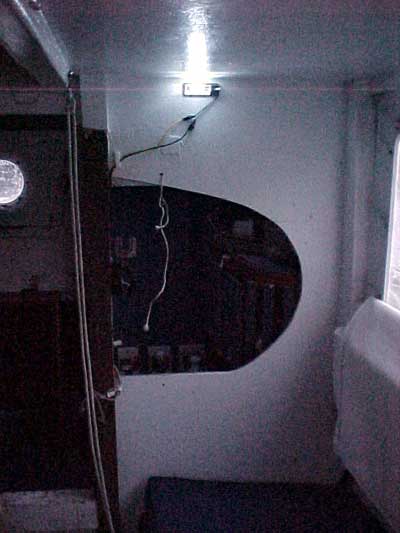
The auto fixture with a festoon light. The line dangling from
the bulkhead is used to hang a rustproof coal miner-type kerosene
lantern for nonelectric light. The lantern was temporarily removed
until after various and assorted hurricanes passed safely by.
The galley is behind the bulkhead, but the Sea Swing cooker
has also been removed for safety, and for home use of the power
fails.
For the dome lights, one
is mounted on the ceiling in the galley (across from the chart
table) and the other in the forward cabin, which is where the
porta-potti is along with storage shelves. Those lights are
a bit dim to read by (not their intended purpose here) but plenty
bright for the necessary activities in both those areas.
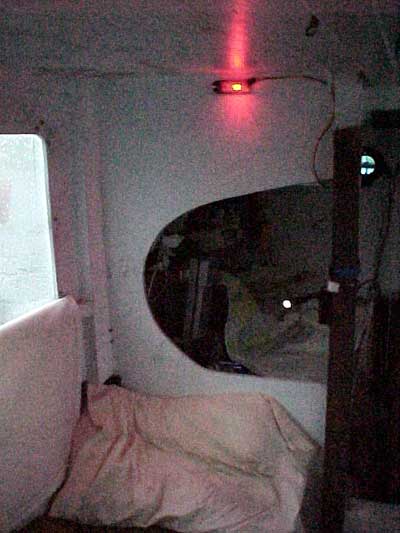
The auto fixture with a festoon light. The line dangling from
the bulkhead is used to hang a rustproof coal miner-type kerosene
lantern for nonelectric light. The lantern was temporarily removed
until after various and assorted hurricanes passed safely by.
The galley is behind the bulkhead, but the Sea Swing cooker
has also been removed for safety, and for home use of the power
fails.
I was tempted, but did
not try an LED fixture with 13 LEDs (available in white and
a variety of colors), it’s also waterproof. It costs less
than $20, and is rated at 260,000 MCDs and a quarter amp of
power consumption. That’s a bit more than four times as
bright as the eight-LED dome lights (remember, all LEDs are
not equal brightness) and more than three times as bright as
the festoons, It has three wires for bright and dim options,
so a three-way switch would be needed. Based on results from
my initial installations, that would provide a good bright cabin
light for my white-painted, 8-by-6.5 foot cabin — but
for now I’m happy.
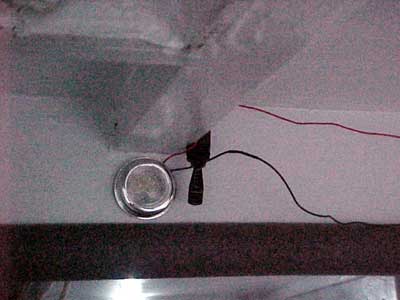
The dome light and switch mounted on the bulkhead in the forward
cabin. The grey band below the light is common foam pipe insulation
from Lowes, glued to the passageway to protect my cranium, or
it might be to protect the bulkhead from my noggin.
The point is, there are
now a variety of power saving LED lights out there, and very
likely bulbs that fit current fixtures you have installed. (You
may have to experiment. For example, if I want to use one of
the nine-LED festoons as a reading light, it will have to be
mounted no more than two feet from what I want illuminated.)
And for the cost of one or two traditional and more energy intensive
cabin lights, I’m able to put a little light everywhere
on the boat, with extra brightness for reading and navigation
areas.
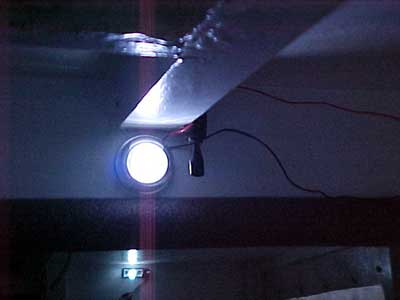
The dome light lit. Below it and in the background is the interior
auto fixture with a festoon bulb.
The LEDs are a great way
to extend your battery power, and become more energy independent.
While the bulbs are still more expensive than other types of
lights, there are savings from not having to add a second battery
or a noisy generator to keep up with power demands. If, like
me, you can be happy with inexpensive fixtures and self-contained
modules, the cost will be less than traditional off-the-shelf
marine cabin lights. And the bulbs will likely never have to
be replaced.
What’s next? Well,
the running lights need to be replaced, and the ones offered
in the Duckworks chandlery take festoon bulbs. But because of
the narrow arc that the festoons illuminate, the housings would
have to be modified to take two bulbs each. But that would make
up for them not being as bright as the incandescent bulbs. Even
with two bulbs each, the running lights would use only a fifth
of an amp, as opposed to nearly two amps with the incandescents.
Hmmm. . . .
For the technically inclined,
below are a couple links that provide detailed information on
LEDs, courtesy of Chris Bacon of Superlumination. The first
link notes the difficulty of comparing incandescents, measure
in lumens, and LEDs, measure in milliamps, but notes that LEDs
are generally considered about five times as efficient as incandescents.
My eyeball evaluations certainly agree with that.
https://autolumination.com/brightness.html
https://autolumination.com/colors.htm
|
|
|

